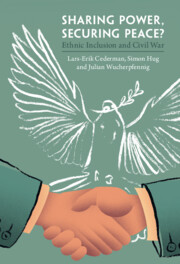1 - Introduction
Published online by Cambridge University Press: 23 June 2022
Summary
This chapter opens by stating the main research question, namely whether power sharing reduces civil conflict or not. After briefly illustrating successful and unsuccessful cases of power sharing, we introduce our approach, which builds on a stream of work in conflict research stressing how exclusion of ethnic groups increased the risk of civil conflict. If this relationship is correct, one would expect the reverse to be true as well. That inclusion of ethnic groups through both territorial and governmental power sharing brings peace is indeed our working hypothesis. Still, there are good reasons to expect that this relationship may be more complicated. There are four main challenges that need to be addressed. First, it is essential not to lose sight of how power sharing is channeled through practices rather than merely being expressions of formal institutions. Second, analysts need to consider full samples rather than focusing only on cases that experienced conflict. Third, rather than being exogenously imposed, power sharing is usually enacted with an eye to future outcomes and is therefore profoundly endogenous to conflict. Finally, it is insufficient to analyze territorial power sharing without considering how pacific outcomes may hinge on whether this type of power sharing is being combined with governmental power sharing at the center. In fact, a failure to come to grips with these difficulties go a long way toward explaining why some researchers find no conflict-reducing effect, and sometimes even a conflict-increasing impact.
- Type
- Chapter
- Information
- Sharing Power, Securing Peace?Ethnic Inclusion and Civil War, pp. 1 - 6Publisher: Cambridge University PressPrint publication year: 2022



